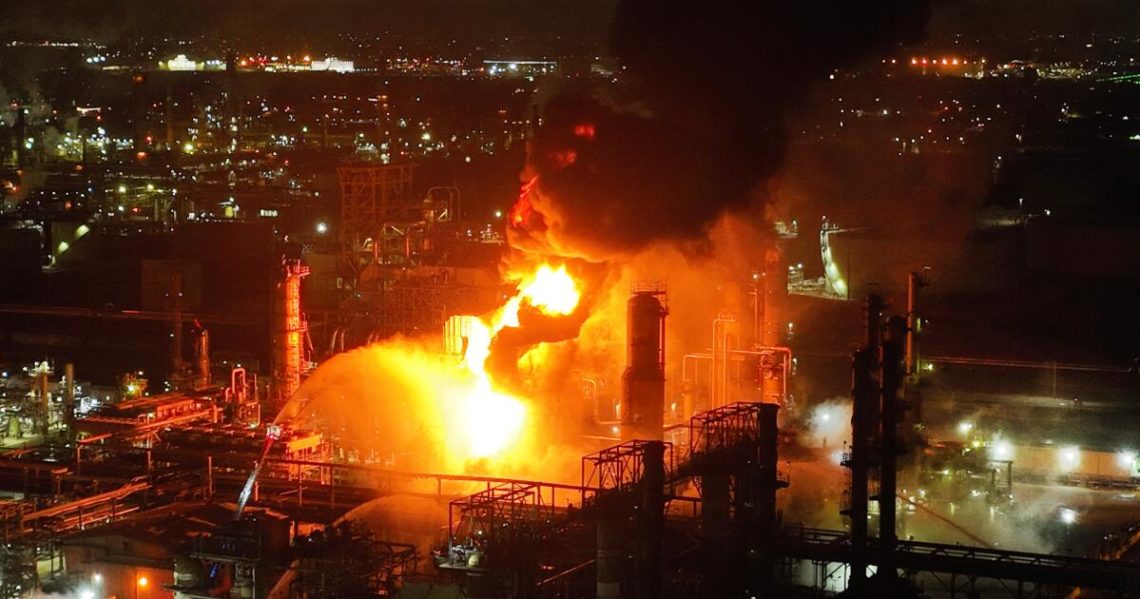The focus of the investigation into what caused a massive explosion and fire last week at Chevron’s El Segundo plant has turned to a jet fuel processing unit in the southeast corner of the sprawling oil refinery.
Chevron officials have said little about what caused the blast but confirmed the Isomax unit, which converts oil into higher-value products such as jet fuel, remains shuttered since the inferno even as other refinery operations continue.
“Until we can figure out everything that happened here and make sure it doesn’t happen again, we won’t restart it,” said Ross Allen, a Chevron spokesperson, adding that the refinery continues to produce jet fuel, as well as gasoline and diesel, from other units.
Although refinery fires are not unheard of — Chevron’s on-site firefighting team specifically prepares for them — industry experts say the sheer scale of the El Segundo fire last week raises concerns about what went wrong and requires a thorough investigation. The blast turned the night skies across the South Bay bright orange and sent out a roar that reverberated for miles. No one died in the incident, and damage was confined to the refinery’s footprint. Only a few workers have reported minor injuries.
“I think Chevron has been extremely, extremely lucky … [given] the size of the explosion here,” said Najmedin Meshkati, a professor of engineering at USC who has served as an expert for the U.S. Chemical Safety and Hazard Investigation Board as it has probed other major refinery fires.
Meshkati and several other experts interviewed by The Times said it was still hard to know exactly what led to the El Segundo fire that night as few details have been shared by local or Chevron investigators, but there are some likely culprits.
Andrew Lipow, president of Houston-based consulting firm Lipow Oil Associates, said that, in his experience, refinery fires can often be traced to equipment failures, especially those that lead to a situation that “allows hot oil and gas to reach the atmosphere.”
“It finds an ignition source, and a fire results,” Lipow said.
An error from the refinery’s oil sensors could lead to a larger system failure, which can end in major flames, according to Faisal Khan, director of the Texas-based Mary Kay O’Connor Process Safety Center, which provides training and education related to chemical safety.
Oil sensors — which monitor well conditions and measure pressure, temperature and flow rates — have been used for a long time. But in the last decade, the technology has advanced to the point where there can be an over-reliance on the data, Khan said. That can lead to issues when refineries don’t have a backup mechanism to track the information or a person who can double-check the updates, he said.
And once such a fire breaks out, it is particularly hard to fight because of how readily available fuel is within a refinery, said Casey Snow, El Segundo Fire Department division chief.
The Fire Department trains to isolate and extinguish these types of fires by “controlling the valves that can restrict the flow” of the fuel, Snow said. It also will use water to try to limit where the active fire could spread.
Neither Chevron nor state and local investigators have provided details on how widespread the fire became Thursday and Friday in El Segundo.
Even though destruction wasn’t obvious from outside the refinery, Lipow said there was probably still significant damage. With a fire that size, the heat alone can melt equipment, and there could be direct fire damage even if it’s not clear to someone looking at the refinery from the outside, he said.
“You can have a fire start at one part of the refinery … and it spreads because there’s just so much intense heat that it causes failures of other pieces of equipment nearby,” Lipow said.
But there is often less dramatic damage to infrastructure — even for the scale of the fire — because these refinery fires are mostly burning fuel.
“Typically, what you see burning is the fuel inside of the unit and not the structure itself,” said Allen, the Chevron spokesperson. “In many cases, firefighters use water to douse and cool nearby structures to keep the fire from spreading further. This minimizes additional damage to the facilities.”
But downplaying the scope of this fire is not helpful, said Meshkati, the USC engineering professor.
He said he hopes officials investigating this fire look for a “confluence of three sets of contributing factors,” which he separates into human-related, organizational and technological factors.
A human factor can be something like an operator error; organizational factors are problems that stem from corporate decisions, such as not providing enough training or staffing; and technological factors are equipment failures, such as corrosion, he said. In the 2015 explosion at the then-Exxon Mobil Corp.’s Torrance refinery, federal investigators found a combination of organizational and technological issues caused the major blast.
“We need to look at each one of those three sets of factors and then to the interaction of those factors,” Meshkati said.
Meshkati’s main concern is that the investigation into this fire may not end up being as thorough and stringent as it could be, especially if the U.S. Chemical Safety and Hazard Investigation Board isn’t fully funded or staffed, as is now the case — a situation that has worried some locals and environmental groups.
“We have not heard or seen from the Chemical Safety Board, which is the premier accident investigator for refineries in the United States,” Meshkati said. “This is, I think, a travesty.”
An inquiry from The Times to the federal chemical board received an automatic out-of-office reply, citing the federal government shutdown. The Trump administration has also proposed budget cuts that would defund the board.
But there are already several other investigations into the fire. Chevron officials said the company is working on its own probe, and the South Coast Air Quality Management District will look into potential violations of air quality rules and permit conditions.
The California Department of Industrial Relations, which includes the Cal/OSHA Process Safety Management Unit, has also opened an investigation into the refinery fire, conducting thorough investigations to determine the cause of incidents and whether any state safety standards were violated.
It wasn’t immediately clear when those findings would be ready, but Chevron is required to submit a report to the air quality district within 30 days analyzing potential causes and equipment breakdowns.
Allen, the Chevron spokesperson, did not respond to a questions about the federal chemical board’s role or a possible timeline for Chevron’s findings from its investigation.
Local authorities reported no injuries after the explosion. But as of Tuesday, four workers have claimed they were harmed in the incident, according to a lawsuit filed in Texas. One of their attorneys, Victoria Alford, said they were injured while they fled the massive explosion, calling the plant workers’ physical injuries “orthopedic in nature,” and said they were also suffering from anxiety.
The post What caused the massive El Segundo explosion? Refinery experts have some theories appeared first on Los Angeles Times.




